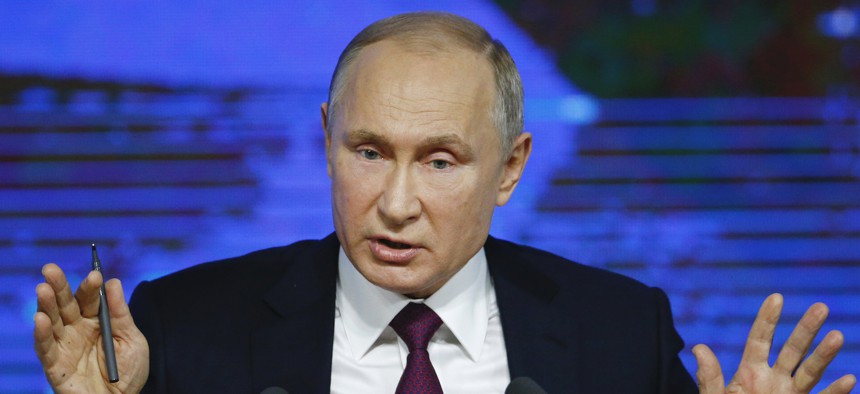
Russian President Vladimir Putin speaks during his annual news conference in Moscow, Russia, Thursday, Dec. 20, 2018 AP Photo/Alexander Zemlianichenko
US: Russia Has Agreed to Extend New START to Tactical Nukes. Russia: No, We Haven’t
Disagreement leaves fate of last remaining strategic arms pact in doubt.
U.S. and Russian diplomats have reached an agreement in principle to extend the New START agreement to tactical nuclear weapons — at least, that’s what U.S. presidential arms control envoy Marshall Billingslea said Tuesday. But Russian officials don’t seem to agree.
The sides have reached an agreement in principle “at the highest levels of our two governments,” Billingslea said at a Heritage Foundation event.
Last week, a unnamed Trump administration touted progress toward such an agreement. On Sunday, the Russian Mission to Vienna poured cold water on the Wall Street Journal’s report.
“#Russia and #US didn’t agree on nuclear arsenals freeze. It’s unclear what the US media information is based upon. Framework agreement on #ArmsControl can be developed at any time should the US accept our proposals,” the embassy said on Twitter.
DFM S.#Ryabkov: #Russia and #US didn’t agree on nuclear arsenals freeze. It’s unclear what the US media information is based upon. Framework agreement on #ArmsControl can be developed at any time should the US accept our proposals. pic.twitter.com/klF4Pv9KsF
— Russian Mission Vienna (@mission_rf) October 10, 2020
And on Tuesday, Russian Deputy Foreign Minister Ryabkov was quoted by the Sputnik media outlet as saying that the freeze terms that the United States was seeking were “unacceptable.”
Russia has said that it would agree to a simple extension of the 2010 treaty, which limits U.S. and Russian deployed strategic nuclear weapons and delivery systems and requires Russia and the United States to allow inspections of their respective stockpiles.
The treaty is set to expire in February. The Trump administration has declined to commit to extending it.
Instead, U.S. officials have tried to persuade their Russian counterparts to expand the treaty’s purview, to subject tactical nuclear weapons to its limits. Estimates of Russia’s stockpile of these lower-yield weapons run from 1,500 to 2,500. Russian officials have even threatened to use them if the United States or NATO allies sent forces to join Ukrainian troops.
“What we’ve indicated to the Russians is that we are in fact willing to extend the New START Treaty for some period of time provided that they agree to a limitation, a freeze, in their nuclear arsenal. We’re willing to do the same. I don’t see how it’s in anyone’s interests to allow Russia to build up its inventory of these tactical nuclear weapons systems with which they like to threaten NATO,” Billingslea said. “We cannot agree to a construct that leaves unaddressed 55 percent or more of the Rusian arsenal.”
But adding tactical nuclear weapons to the items covered by New START means changing the agreement in a fundamental way and it wasn’t clear that Russia had actually agreed to a new freeze on a weapon type that makes up an increasingly-large part of its arsenal.
MIT associate professor Vipin Narang took to Twitter to highlight the gap between Billingslea’s assessment of the current state of agreement versus that of Russian officials.
“The Trump Adm will claim this as a win, I'm sure. But the Russians just ran the clock down and got a temporary New START extension without giving anything up on return, and it doesn't seem like the Administration's promise to bring Russian tactical nukes in is even on the table,” he said.
The Trump Adm will claim this as a win, I'm sure. But the Russians just ran the clock down and got a temporary New START extension without giving anything up on return, and it doesn't seem like the Administration's promise to bring Russian tactical nukes in is even on the table. https://t.co/nqPFW6rpTi
— Vipin Narang (@NarangVipin) October 13, 2020
Kingston Reif, the director for Disarmament and Threat Reduction Policy at the Arms Control Association, said "contrary to Billingslea's claim that there is an agreement in principle with Russia on the freeze concept, the gap between the two sides at this point still appears in need of some significant closing." He said that a politically-binding freeze on the total U.S. and Russian nuclear warhead stockpiles, paired with a five-year New START extension, "would be a useful confidence-building measure as the two sides pursue talks on more formal and verifiable arms control arrangements...A five-year extension remains in the U.S. and Russian interest with or without a freeze and should not be held hostage to a freeze," he said.
Before they tried to persuade Russia to expand the arms-control treaty, U.S. officials had been pushing the notion of three-way talks. China, which has a much smaller nuclear arsenal than the United States and Russia, rejected the idea.
Nevertheless, Billingslea on Monday said that there was a broad understanding between the United States and Russia that “The next treaty is going to have to be multilateral.”
Without an extension of the New START agreement, the United States and Russia would be free to produce more nuclear warheads as well as weapons platforms and would not have to submit to inspections.
A March 2019 paper from the Center for Naval Analysis notes that without New START, “The United States would face an opportunity cost of diverting scarce national technical means (NTM), such as satellites, and technical analysts from other missions. Russian defense officials would also navigate increased uncertainty and lose the ability to confirm that the United States has not reversed its New START reductions. Neither country would have the same degree of confidence in its ability to assess the other’s precise warhead levels. Worst-case scenario planning is also more likely as a result.”




